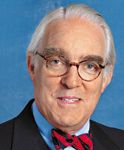Article
Laser treatment in CAPT neither beneficial nor harmful
Author(s):
Las Vegas-Laser treatment as applied in the Complications of Age-Related Macular Degeneration Prevention Trial (CAPT) proved to be neither beneficial nor harmful after 5 years of follow-up when compared with eyes that were observed for that period, Stuart Fine, MD, reported at the American Academy of Ophthalmology (AAO) annual meeting.

The CAPT, a 22-site prospective study that was supported for 8 years by the National Eye Institute, was born out of the desire to determine whether low-intensity laser treatment could decrease the incidence of vision loss in patients with large high-risk drusen in both eyes. The CAPT investigators reported their findings in the November issue of Ophthalmology (2006;113:1974-1986).
To participate in the study, patients satisfied the following criteria: the presence of more than 10 large drusen (exceeding 125 µm) in each eye, visual acuity better than 20/40 in each eye, aged more than 50 years, and the presence of no other ocular disease that could interfere with assessment of the visual outcome, Dr. Fine said.
A total of 1,052 patients participated in the study, and they were followed for at least 5 years. The primary outcome measure was a change in visual acuity, and the secondary outcome measures were the incidence of late AMD, contrast thresholds, reading vision, and the side effects of treatment, according to Dr. Fine.
Only 3% of the follow-up visits were missed over the 5- to 6-year follow-up; 87% of patients completed the 5-year examination, with only 42 living patients missing the 5-year visit.
An important finding in the study, according to Dr. Fine, was that "laser-treated eyes were far more likely to experience a 50% or greater reduction in baseline drusen compared with the observed eyes."
A loss of visual acuity that exceeded 3 or more lines was the principal outcome of interest.
"At the 5-year visit, 21% of eyes treated with laser and observed eyes lost 3 or more lines of vision," he said. At 6 years, that percentage for both groups increased to 24%. This lack of a difference in visual outcomes is similar to what had been reported at the 2005 AAO meeting by Thomas Friberg, MD, and colleagues for the Prophylactic Treatment of Age-Related Macular Degeneration Study Group, Dr. Fine pointed out. This study was reported in the April issue of Ophthalmology (2006;113:612-622).
In the study under discussion, the incidence of late AMD continued to increase with each passing year but did not differ between treated and observed eyes. At 5 years, 20% of treated eyes and 20% of observed eyes developed late AMD. Similarly, the incidence of choroidal neovascularization (CNV) did not differ between treated and observed eyes. At 5 years, 13% of eyes in each group had developed CNV. In addition, the incidence of geographic atrophy at 5 years was identical in treated and observed eyes, 7.5%. The mean visual acuity at the first visit was 20/25 + 2, and at the 5-year follow-up visit, it was 20/40 +3. The mean visual acuity lost over the 5-year period was about 2 lines. At baseline, 50% of the eyes had 20/20 or better visual acuity, and at 5 years only 31% had that level of vision, according to Dr. Fine.
Newsletter
Don’t miss out—get Ophthalmology Times updates on the latest clinical advancements and expert interviews, straight to your inbox.




